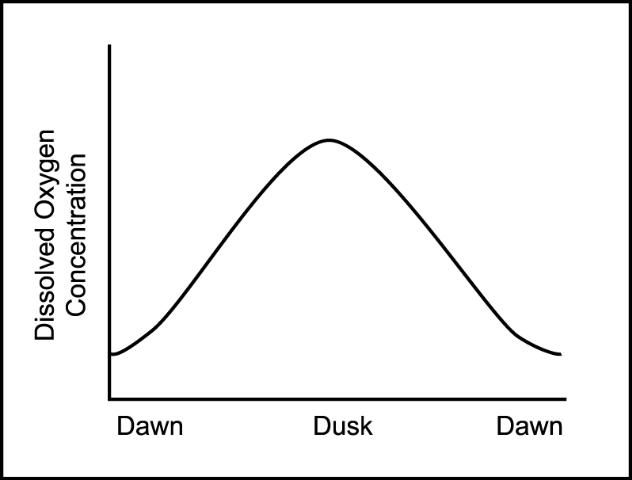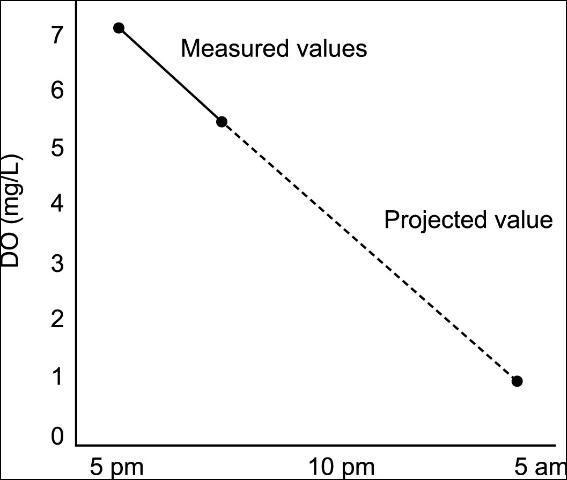What is dissolved oxygen?
Dissolved oxygen (DO) refers to oxygen gas that is dissolved in water. Fish "breathe" oxygen just as land animals do. However, fish are able to absorb oxygen directly from the water into their bloodstream using gills, whereas land animals use lungs to absorb oxygen from the atmosphere.
What are the sources of oxygen in an aquatic environment?
There are three main sources of oxygen in the aquatic environment: 1) direct diffusion from the atmosphere; 2) wind and wave action; and 3) photosynthesis. Of these, photosynthesis by aquatic plants and phytoplankton is the most important in outdoor pond systems.
In ponds or tanks with algae or plants, oxygen, derived from photosynthesis, is produced during the day when sunlight shines on the plants in the water. Oxygen levels drop at night because of respiration by plants and animals, including fish. These predictable changes in DO that occur every 24 hours are called the diurnal oxygen cycle (Figure 1).

What is oxygen depletion?
Oxygen depletion refers to low levels of DO and may result in fish mortality. A concentration of 5 mg/L DO or more is recommended for optimum fish health. Sensitivity to low levels of dissolved oxygen is species specific, however, most species of fish are distressed when DO falls to 2–4 mg/L. Mortality usually occurs at concentrations less than 2 mg/L. The number of fish that die during an oxygen depletion event is determined by how low the DO gets and how long it stays down. Usually larger fish are affected by low DO before smaller fish are.
What causes oxygen depletion?
Oxygen depletion occurs when oxygen consumption exceeds oxygen production. Increases in oxygen consumption can be caused by an over-abundance of aquatic plants or algae in the ecosystem, "turnover" of a body of water (see Stratification/Pond Turnover section), increased organic waste entering the water (i.e., manure from feedlots, septic tank waste water, and excess fish feed), death and decay of organic matter (i.e., plant or algae die-offs), or by certain chemicals (i.e., formalin) that remove oxygen directly from the water column.
Why are oxygen depletion events most troublesome in the summer?
In outdoor ponds, oxygen depletion events can occur at anytime, however, they are most likely to cause fish kills during hot summer weather. A decrease in oxygen production is caused by incidents such as cloudy weather and plant or algae die-offs that shut down photosynthesis. Heavy populations of plants or algae are the most important producers of oxygen in the system. However, they are also the most important users of oxygen. There are several reasons why oxygen depletion events are more common in the summer and they are discussed below.
High Water Temperature
Warm water is much less capable of holding oxygen gas in solution than cool water. For example, water that is 90°F can only hold 7.4 mg/L DO at saturation, whereas water that is 45°F can hold 11.9 mg/L DO at saturation. This physical phenomenon puts the fish in double jeopardy because at high water temperatures their metabolic rates increase, hence their physiologic demand for oxygen increases.
Cloudy, Still Weather
Muggy, overcast summer days often precipitate oxygen depletions. During cloudy weather, the intensity of light reaching surface waters is greatly diminished, resulting in a marked decrease in oxygen production from photosynthesis. Oxygen consumption, however, remains unchanged. This results in a net loss of oxygen over each 24-hour period. This loss of oxygen from decreased production is confounded by still, muggy, humid weather common on overcast summer days. Oxygen transfer (from the atmosphere into the water) is minimal because there is little or no wind/wave action. The net result over a period of several days is oxygen depletion and, often, fish kills.
Stratification/Pond Turnover
During hot weather, surface waters warm up more rapidly than deeper waters. As the difference in temperature increases between warm surface water and cool bottom water, a thermocline develops. A thermocline is an area of rapid temperature change that acts as a physical barrier between warm water at the surface (epilimnion) and cold water at the bottom (hypolimnion). When a thermocline is present there is no mixing of surface and deep layers of water. Because photosynthesis and oxygen production only occur near the surface, water in the deep layer becomes devoid of oxygen and develops an oxygen demand. Decomposition of organic matter, including uneaten feed or dead plant material, occurs at the bottom of the pond and is an oxygen consuming process. Hence the bottom layer becomes anoxic because the oxygen present is used up but there is no source of new oxygen molecules due to presence of the thermocline.The thermocline can be broken by heavy wind and cold rain, common during summer thunderstorms. When the thermocline breaks down, the oxygen-rich surface waters mix with oxygen-deficient bottom waters. If the oxygen demand is sufficient, all DO present will rapidly be removed from the water column, resulting in severe oxygen depletion and a fish kill.
How to Determine if Low DO Is the Cause of a Fish Kill
- All fish die at approximately the same time (often during the night or in the pre-dawn hours).
- Large fish may be affected more than small fish.
- Moribund fish may be seen at the surface "gasping" for oxygen (this is called "piping").
- Some species may die with their back arched, gills flared and mouth open. This is most commonly seen in hybrid striped bass and, occasionally, in catfish.
- The weather immediately prior to the fish kill may have been hot, still and overcast. A severe thunderstorm may have occurred immediately prior to the fish kill.
- An oxygen depletion event severe enough to result in significant fish mortality is often observed in water with heavy populations of algae or aquatic plants.
What to Do if Low DO Is Suspected as the Cause of a Fish Kill
The most important thing to do if fish are dying from low DO is to turn on an aerator. If emergency aeration is not available, little can be done to help the fish. To confirm the problem, oxygen levels should be tested while the fish kill is in progress. Some county extension agents are equipped with water testing equipment. In addition, biologists with the Florida Game and Freshwater Fish Commission or an UF/IFAS Extension Aquaculture Specialist may be available to assist.
Preventing Oxygen Depletion
An oxygen depletion event can be predicted and, therefore, prevented by monitoring dissolved oxygen levels in a pond. The most efficient tool for measuring DO is an electronic oxygen meter. These instruments are available through most aquaculture supply companies at a variety of prices. Chemical test kits are also available. These are more troublesome to run, but are accurate and do not require as great an investment by pond owners.
Commercial catfish farms often hire night oxygen crews to monitor the DO concentration in each pond at two-hour intervals through the night. This is the surest way of avoiding a fish kill caused by low DO. Aeration systems can be turned on if oxygen levels drop below a certain concentration (usually 2–4 mg/L) depending on the fish species.
Monitoring oxygen throughout the night is impractical for recreational pond owners and part-time fish farmers. For these people it is easier to "predict" an oxygen depletion by measuring DO levels in the late afternoon (5pm–6pm) and late evening (8pm–10pm). The decline in DO during the night can be predicted by graphing DO concentration against time on standard graph paper (Figure 2). If the projected concentration of DO is below 4 mg/L before 7am emergency aeration is recommended.

If equipment to test DO concentration (meter or test kit) is not available, the following observations and conditions can be used to anticipate oxygen depletion:
- Fish swim at or near the surface gulping air (piping).
- Fish suddenly stop feeding.
- There is a rapid change in water color from to brown, black or gray, signifying loss of an algal bloom.
- A putrid odor arises from the water.
- There has been an extended period of hot cloudy weather.
- There is a heavy summer wind and a rainstorm.
Emergency aeration should be applied whenever fish show signs of oxygen depletion or when dissolved oxygen drops below 4 mg/L.
Many recreational pond owners purchase aerators and place them on electric timers. Proper use of the timer should have the aerator turn on during the late evening (10pm to midnight) and turn off after daylight (7am–8am). Running an aerator during the day is not generally recommended as it will actually blow oxygen out of the pond and into the atmosphere since most ponds are supersaturated with oxygen in the afternoon. If aerators are left on during the day for aesthetic reasons, they should continue to run throughout the night. Using an aerator is not a complete substitute for monitoring DO concentrations and an oxygen depletion event resulting in a fish kill may still occur. However, use of an aerator is recommended and will prevent many problems.
Summary
Dissolved oxygen (DO) is oxygen gas (O2) that is dissolved in water. Most DO in ponds is produced during photosynthesis by aquatic plants and algae. For this reason DO increases during daylight hours, declines during the night, and is lowest just before daybreak. Dissolved oxygen concentrations below 5 mg/L may be harmful to fish and piping (gulping air at the surface) may be observed when DO falls below 2 mg/L. Low levels of DO are most frequently associated with hot, cloudy weather, algae die-offs, or heavy thunderstorms. Dissolved oxygen can be monitored using an electronic oxygen meter or chemical test kit. Emergency aeration should be supplied whenever DO falls below 4 mg/L or environmental conditions favor an oxygen depletion event.